The Clot Busting Drugs Market is estimated to be valued at USD 35.6 billion in 2025 and is projected to reach USD 72.0 billion by 2035, registering a compound annual growth rate (CAGR) of 7.3% over the forecast period.
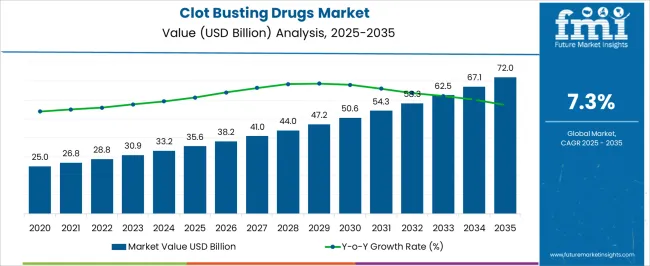
| Metric | Value |
|---|---|
| Clot Busting Drugs Market Estimated Value in (2025 E) | USD 35.6 billion |
| Clot Busting Drugs Market Forecast Value in (2035 F) | USD 72.0 billion |
| Forecast CAGR (2025 to 2035) | 7.3% |
The clot busting drugs market is witnessing steady growth, fueled by the global rise in cardiovascular and thrombotic disorders and the increasing demand for rapid therapeutic intervention. Advances in clinical research, the introduction of time-sensitive treatment guidelines, and improved diagnostic imaging are accelerating the timely administration of thrombolytic agents.
Healthcare systems are focusing on reducing mortality and long-term disability rates associated with acute thrombotic events, creating favorable conditions for the adoption of clot dissolving therapeutics. Regulatory agencies and global health organizations are endorsing emergency use protocols and fast-track approval mechanisms, supporting faster market penetration of new formulations.
The ongoing shift from surgical interventions to pharmacological management for clot resolution is expected to sustain long-term demand. Future expansion is likely to be reinforced by improved access in developing regions, innovation in drug delivery, and the development of targeted therapies with fewer bleeding-related side effects.
The market is segmented by Product Type, Indication, Route of Administration, and Distribution Channel and region. By Product Type, the market is divided into Thrombolytic Drugs, Anti-Platelet Drugs, Anticoagulants, and Others. In terms of Indication, the market is classified into Pulmonary Embolism, Deep Vein Thrombosis, Atrial Fibrillation, and Others. Based on Route of Administration, the market is segmented into Injectable and Oral. By Distribution Channel, the market is divided into Hospital Pharmacy, Drug Store, Online Pharmacy, and Retail Pharmacy. Regionally, the market is classified into North America, Latin America, Western Europe, Eastern Europe, Balkan & Baltic Countries, Russia & Belarus, Central Asia, East Asia, South Asia & Pacific, and the Middle East & Africa.
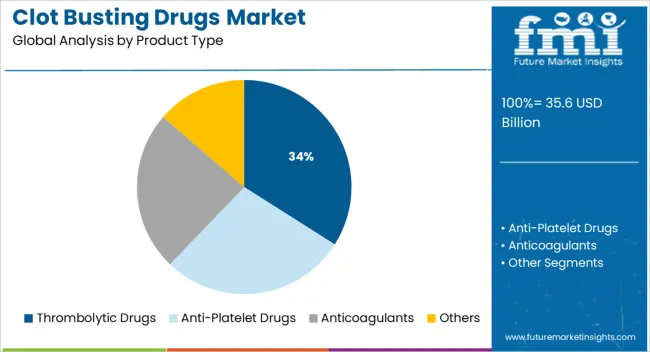
Thrombolytic drugs are anticipated to account for 34.0% of the total revenue in the clot busting drugs market by 2025, making them the leading product type segment. This dominance is being driven by their widespread clinical use in managing acute events such as myocardial infarction, ischemic stroke, and deep vein thrombosis.
The proven efficacy of these agents in dissolving fibrin clots and restoring blood flow in time-sensitive emergencies has led to their prioritization in emergency care protocols. Hospitals and trauma centers are increasingly standardizing thrombolytic administration as part of their acute care pathways.
Moreover, continuous improvements in drug safety profiles, dosing precision, and reduced hemorrhagic risks have supported their market leadership. Public awareness campaigns and physician training initiatives are further promoting early detection and treatment, thereby expanding therapeutic windows and patient outcomes.
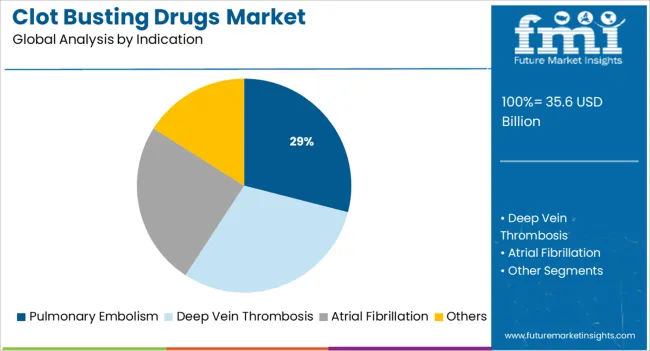
Pulmonary embolism is expected to generate 29.0% of the overall market revenue in 2025, positioning it as the top indication segment. This prominence is being shaped by increasing global incidence rates, sedentary lifestyles, and rising surgical interventions, which elevate venous thromboembolism risk. Pulmonary embolism presents high mortality risk if untreated, prompting clinical urgency in its diagnosis and management.
Use of clot busting drugs has become central to treatment in moderate to severe cases, particularly among patients unsuitable for invasive procedures. Adoption is being supported by updated clinical guidelines that advocate systemic thrombolysis in high-risk scenarios.
Enhanced awareness, improved CT pulmonary angiography access, and point-of-care diagnostics are enabling faster decision-making and timely therapeutic administration. The emphasis on early hospital discharge and outpatient treatment options is also reinforcing demand for pharmacologic solutions in managing pulmonary embolism.
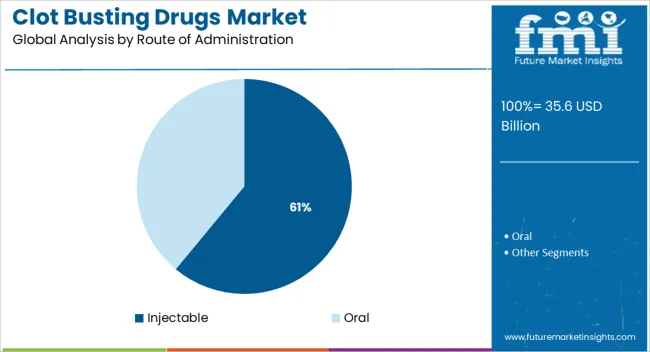
Injectables are projected to contribute 61.0% of the total market revenue in 2025, solidifying their position as the leading route of administration. This segment’s dominance is being attributed to the need for immediate therapeutic action in acute care settings where clot lysis is time-critical.
Intravenous and subcutaneous delivery ensures rapid systemic availability, making injectables the preferred option in emergency and intensive care units. Clinical familiarity, established dosing regimens, and ease of administration in controlled environments have made this route standard in hospital-based treatment algorithms.
Additionally, advancements in prefilled syringe technology and auto-injector devices are improving convenience and compliance in both inpatient and pre-hospital emergency scenarios. As point-of-care thrombolysis gains momentum, injectable clot busting drugs are expected to remain central to frontline medical response strategies.
The overall, clot busting drugs market sales account for approximately 17.3% of revenue share in the global cardiovascular drugs market, which was valued at around USD 33.2 Billion in 2024.
The global market for clot busting drugs recorded a historic CAGR of 7.3% in the last five years from 2020 to 2024.
The global market for clot busting drugs will be supported globally over the forecast period by the growing need for pharmaceuticals to treat heart attacks and strokes promptly. The development of clot busting therapeutic options and improvements in the pharmaceutical sector will further boost the growth of the global market for clot busting drugs.
Furthermore, as cardiovascular disorders like heart attacks and strokes become more common, the demand for clot busting drugs is anticipated to rise. The fifth most common cause of death in the USA is a stroke. The rising frequency of strokes needs an immediate response, and clot buster drugs can assist by dissolving the blood clot accumulating in the veins, which reduces blood pressure.
Strokes are increasing the rate of death in the population, which is causing the market for clot busting drugs to expand globally. Additionally, during the course of the forecast period, the increased risk of ischemic stroke in the global population is anticipated to boost the global market for clot busting drugs.
Additionally, stroke is the second leading cause of mortality worldwide, accounting for an estimated 5.5 million fatalities annually. Along with the enormous morbidity caused by stroke, which results in up to 50% of survivors having a long-term disability, there is also a significant mortality rate. As a result, stroke is a condition that is very important to public health and has major economic and social repercussions.
The global health impact of a stroke is expected to rise in the next years, especially in developing countries, which will boost the need for clot-busting drugs.
The cost of clot busting drugs that have shown to be particularly effective in treating ischemic stroke patients has more than doubled, considerably outpacing any Medicare/Medicaid reimbursements to hospitals that employ the medication.
Over the previous ten years, the price of alteplase (a clot busting drug) has climbed by 111%. According to Cardiovascular Business, the drug is particularly helpful in treating patients' acute ischemic stroke symptoms. If taken during the first few hours of a stroke, the medicine can frequently completely reverse its effects.
The global clot busting drugs market is thus likely to show high growth over the coming years a CAGR value of 7.3% and reach a global market size of USD 72 Billion by 2035.
During the projected period, there will be an increase in demand for pharmaceuticals to quickly treat heart attacks and strokes, which will lead to growth in the global market for clot-busting drugs. Developments in the pharmaceutical sector and the creation of clot-busting therapy options both influence the market's potential future expansion.
Tenecteplase, a newer generation clot busting medicine, outperforms the standard treatment for ischemic strokes in a number of critical areas, including improved health outcomes and lower costs, according to research that was conducted by the American Stroke Association.
The market for clot busting drugs will experience growth globally during the forecast period due to the increasing need for pharmaceutical products to promptly treat heart attacks and strokes.
For instance, non-fibrin-specific medications include plasminogen activating complex, streptokinase, and urokinase. Blood coagulation in the lungs is treated with urokinase, a drug of the serine protease class. Myocardial infarction, pulmonary embolism, and arterial thromboembolism are all conditions that are treated using the thrombolytic drug streptokinase.
The introduction of these innovative and better alternatives is expected to create a lucrative market for drug manufacturers and increase the adoption rate of their products, which will drive the Clot Busting drugs market in the projected period.
Drugs that target fibrin are fibrinolysis-inducing substances with negligible lytic effects, yet in stroke situations, they function as blood thinners. Tissue plasminogen activator (tPA), one of these medications, initiates the blood clots' disintegration when a stroked state is present.
The medication is exceedingly risky and should only be used under medical supervision due to the potential side effects of brain damage, paralysis, or even impaired speech. The tPA raises the likelihood of bleeding, it may not be possible for patients with a history of bleeding problems, recent operations, unstable blood pressure, or a recent severe concussion to get it.
A safe dose of the drug, which is administered intravenously, frequently does not remain in the bloodstream long enough to dissolve the large clots, and increasing the dose increases the risk of bleeding even though it is effective against smaller clots in thinner capillaries.
Additional adverse effects of these clot busting medications include bleeding from wounds or the area where the drug was shot, an allergic response, fever, reduced blood pressure, and signs of bleeding from other parts of the body, such as nosebleeds, black tarry stools, blood in the urine, and gum bleeding.
The aforementioned factors can serve as potential barriers to the expansion of the clot busting drugs market in the future.
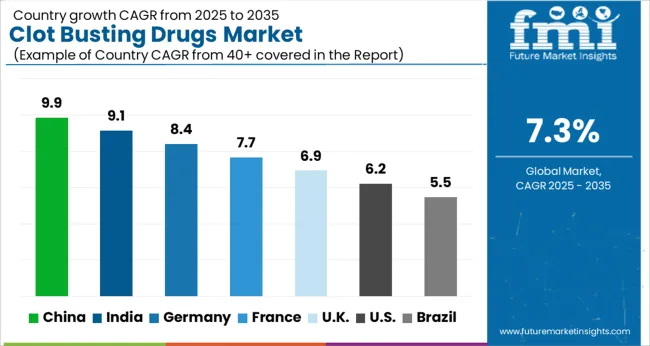
The USA has dominated the North American region by reaching a worth of USD 33.2 Billion while withholding the vast majority of the worldwide market share of roughly 31.1% in 2024.
Nearly 8 lac strokes occur each year in the USA blood clot that blocks a vein supplying blood to the brain causes more than 85% of these strokes to be ischemic. The USA is anticipated to grow during the projected period for the same reason.
As of 2024, Germany has led the European clot busting drugs market withholding about 7.6% of the global market share. In Germany, between 30 to 40% of adults have excessive blood pressure. With age, the percentage rises. Every second individual is impacted starting around age 60. It may result in deadly outcomes such as cardiac arrhythmias, renal failure, a stroke, or a heart attack.
With a growing number of drug manufacturers for the conditions like stroke and an increasing pipeline of clot busting drugs, Germany clot busting drugs market is expected to show substantial growth over the projected period.
China accounted for USD 1.6 Billion withholding the majority of the East Asian market share as of 2024. With an aging population, China has made significant progress in reforming its healthcare system. It currently offers a basic kind of universal health insurance and generously subsidizes an expanding list of essential medications.
In an effort to make medicines, including certain products from Pfizer, GlaxoSmithKline, and Novartis, more affordable, China is expected to reduce the prices of roughly 400 drugs for respiratory disorders, fever, cardiovascular diseases, and pain by up to 20%. This is expected to boost the market for clot busting drugs in the future too within this region.
By product, anticoagulants have driven the global market by achieving a valuation of about USD 33.2 Billion in 2024 withholding the majority of the global market share of about 36.7%. Due to the rise in chronic diseases, the development of anticoagulant medicines has become more molecularly and biologically advanced. Emerging nations are increasingly using novel oral anticoagulants (NOACs) and over the forecast period, increasing product launches and approvals are anticipated to support market expansion.
For instance, Natco Pharma introduced a rivaroxaban molecule under the trade name RPIGAT in December 2024. This anticoagulant drug is used to treat and prevent blood clots.
By indication, pulmonary embolism has led the global market by achieving a valuation of USD 8.4 Billion by the end of 2024. The demand for clot busting drugs is expected to increase because those who are receiving chemotherapy or who have a family history of pulmonary embolism are most at risk. The market is expected to thrive as the number of cancer patients increases.
In 2024, cancer was responsible for around 10 million deaths, according to the World Health Organization. Additionally, it is projected that rising government investments to enhance public healthcare systems will accelerate market expansion.
The injectable dominated the market in terms of route of administration and is predicted to continue expanding, accounting for more than half of the global market. The primary factors driving the growth of this market are the increasing use of biological drugs, the number of chronic diseases, the surge in sharps injuries, and the benefits of injectables. These problems have raised the demand for devices like safety syringes, prefilled syringes, and auto-injectors.
By distribution channel, hospital pharmacies have led the global market by generating nearly one-third of the global revenue as of 2024. The growing incidence of chronic diseases, patient compliance, and the wide & easy availability of a variety of products within the hospital premises are all responsible for the high percentage of this segment.
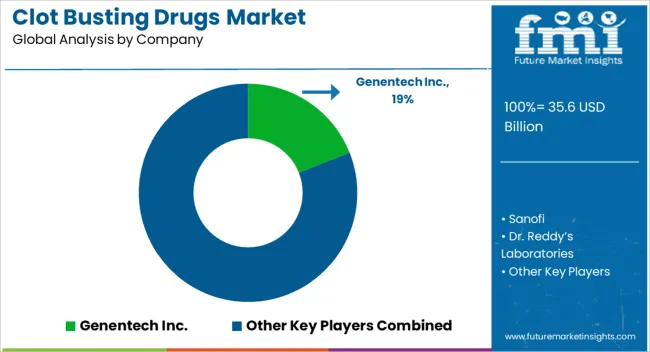
Tissue plasminogen activator (tPA) and thrombolytic drugs have changed how heart attack patients are treated, and they have sparked competition among pharmaceutical companies.
In order to introduce new technologies and therapies, major companies in the global market for clot busting drugs are investing in research and development operations. To acquire a competitive edge, several of the other companies want to get product approvals for their new items. For example,
| Attribute | Details |
|---|---|
| Forecast Period | 2025 to 2035 |
| Historical Data Available for | 2020 to 2024 |
| Market Analysis | USD Billion for Value |
| Key Regions Covered | North America; Latin America; Europe; East Asia; South Asia; Oceania; and Middle East & Africa (MEA). |
| Key Countries Covered | USA, Canada, Brazil, Mexico, Argentina, Rest of Latin America, United Kingdom, Germany, Italy, Russia, Spain, France, BENELUX, Nordic Countries, Rest of Europe, Japan, China, South Korea, India, Thailand, Indonesia, Malaysia, Vietnam, Philippines, Australia, New Zealand, Turkey, GCC, South Africa, Israel, North Africa and Rest of MEA. |
| Key Market Segments Covered | Product, Indication, Route of Administration Distribution Channel and Regions. |
| Key Companies Profiled | Sanofi; Dr. Reddy’s Laboratories; Bayer AG; Boehringer Ingelheim Gmbh.; Genentech Inc.; Eli Lilly and Company; Johnson & Johnson Services Inc.; The Medicines Company; Pfizer Inc. |
| Pricing | Available upon Request |
The global clot busting drugs market is estimated to be valued at USD 35.6 billion in 2025.
The market size for the clot busting drugs market is projected to reach USD 72.0 billion by 2035.
The clot busting drugs market is expected to grow at a 7.3% CAGR between 2025 and 2035.
The key product types in clot busting drugs market are thrombolytic drugs, anti-platelet drugs, anticoagulants and others.
In terms of indication, pulmonary embolism segment to command 29.0% share in the clot busting drugs market in 2025.






Our Research Products

The "Full Research Suite" delivers actionable market intel, deep dives on markets or technologies, so clients act faster, cut risk, and unlock growth.

The Leaderboard benchmarks and ranks top vendors, classifying them as Established Leaders, Leading Challengers, or Disruptors & Challengers.

Locates where complements amplify value and substitutes erode it, forecasting net impact by horizon

We deliver granular, decision-grade intel: market sizing, 5-year forecasts, pricing, adoption, usage, revenue, and operational KPIs—plus competitor tracking, regulation, and value chains—across 60 countries broadly.

Spot the shifts before they hit your P&L. We track inflection points, adoption curves, pricing moves, and ecosystem plays to show where demand is heading, why it is changing, and what to do next across high-growth markets and disruptive tech

Real-time reads of user behavior. We track shifting priorities, perceptions of today’s and next-gen services, and provider experience, then pace how fast tech moves from trial to adoption, blending buyer, consumer, and channel inputs with social signals (#WhySwitch, #UX).

Partner with our analyst team to build a custom report designed around your business priorities. From analysing market trends to assessing competitors or crafting bespoke datasets, we tailor insights to your needs.
Supplier Intelligence
Discovery & Profiling
Capacity & Footprint
Performance & Risk
Compliance & Governance
Commercial Readiness
Who Supplies Whom
Scorecards & Shortlists
Playbooks & Docs
Category Intelligence
Definition & Scope
Demand & Use Cases
Cost Drivers
Market Structure
Supply Chain Map
Trade & Policy
Operating Norms
Deliverables
Buyer Intelligence
Account Basics
Spend & Scope
Procurement Model
Vendor Requirements
Terms & Policies
Entry Strategy
Pain Points & Triggers
Outputs
Pricing Analysis
Benchmarks
Trends
Should-Cost
Indexation
Landed Cost
Commercial Terms
Deliverables
Brand Analysis
Positioning & Value Prop
Share & Presence
Customer Evidence
Go-to-Market
Digital & Reputation
Compliance & Trust
KPIs & Gaps
Outputs
Full Research Suite comprises of:
Market outlook & trends analysis
Interviews & case studies
Strategic recommendations
Vendor profiles & capabilities analysis
5-year forecasts
8 regions and 60+ country-level data splits
Market segment data splits
12 months of continuous data updates
DELIVERED AS:
PDF EXCEL ONLINE
Cloth Drying Machine Market Size and Share Forecast Outlook 2025 to 2035
Clothing Fibers Market Size and Share Forecast Outlook 2025 to 2035
Cloth Diaper Market Analysis by Type, Application,Distribution Channel and Region Through 2025 to 2035
Clothing Recycling Market Analysis – Growth & Trends 2025 to 2035
Cloth Self-adhesive Tapes Market
Cloth Cutting Machines Market
Pet Clothing Market Size and Share Forecast Outlook 2025 to 2035
Sailcloth Market Growth – Trends & Forecast 2022 to 2032
Drop Cloth Market Analysis - Trends, Growth & Forecast to 2035
Glass Cloth Electrical Insulation Tape Market Size and Share Forecast Outlook 2025 to 2035
Blood Clot Retrieval Devices Market Size and Share Forecast Outlook 2025 to 2035
Vegan Clothing Market Analysis - Size, Share and Forecast 2025 to 2035
Smart Clothing Market – Wearable Tech & Health Insights
Online Clothing Rental Market Size and Share Forecast Outlook 2025 to 2035
Assessing Online Clothing Rental Market Share & Industry Insights
Workout Clothes Market Size and Share Forecast Outlook 2025 to 2035
Acetate Cloth Tape Market Size and Share Forecast Outlook 2025 to 2035
Braille Clothing Tags Market Size and Share Forecast Outlook 2025 to 2035
Cosplay Clothing Market Trends - Growth & Forecast to 2025 to 2035
Industry Share Analysis for Braille Clothing Tags Companies

Thank you!
You will receive an email from our Business Development Manager. Please be sure to check your SPAM/JUNK folder too.
Chat With
MaRIA